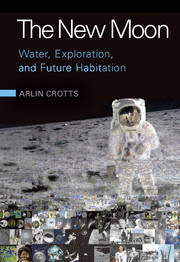Book contents
- Frontmatter
- Contents
- Preface
- Acknowledgements
- Chapter 1 The Importance of the Moon
- Chapter 2 First Steps
- Chapter 3 Moon/Mars
- Chapter 4 An International Flotilla
- Chapter 5 The Moon Rises from the Ashes
- Chapter 6 Moons Past
- Chapter 7 The Pull of the Far Side
- Chapter 8 Water in a Land of False Seas
- Chapter 9 Inconstant Moon
- Chapter 10 Moonlighting
- Chapter 11 Lunar Living Room
- Chapter 12 Lunar Power
- Chapter 13 Stepping Stone
- Chapter 14 Return to Earth
- Glossary
- Appendix A Von Braun et al. Space and Lunar Exploration Issues
- Appendix B Topics in Transient Phenomena on the Moon
- Index
- References
Chapter 9 - Inconstant Moon
Published online by Cambridge University Press: 05 September 2014
- Frontmatter
- Contents
- Preface
- Acknowledgements
- Chapter 1 The Importance of the Moon
- Chapter 2 First Steps
- Chapter 3 Moon/Mars
- Chapter 4 An International Flotilla
- Chapter 5 The Moon Rises from the Ashes
- Chapter 6 Moons Past
- Chapter 7 The Pull of the Far Side
- Chapter 8 Water in a Land of False Seas
- Chapter 9 Inconstant Moon
- Chapter 10 Moonlighting
- Chapter 11 Lunar Living Room
- Chapter 12 Lunar Power
- Chapter 13 Stepping Stone
- Chapter 14 Return to Earth
- Glossary
- Appendix A Von Braun et al. Space and Lunar Exploration Issues
- Appendix B Topics in Transient Phenomena on the Moon
- Index
- References
Summary
In observational fields fortune favors the prepared mind. (Dans les champs de l’observation le hasard ne favorise que les spirits préparés.)
– Louis Pasteur, December 7, 1854, lecture, Université de LilleNow we are mapping the Moon. Unlike past times when mapping meant sailing or walking to geographic features to mark them on a map, or peering through a telescope from Earth, our robots orbit tens of kilometers overhead and remotely characterize each lunar surface parcel (pixel) in optical light, infrared, particle flux, radar, elevation, and a dozen other techniques. It may seem we will soon describe the Moon completely. It is secure science: if a scientist discovers something, it will still be there on the next orbit in two hours, or when the spacecraft passes overhead two weeks or a month later, or next year, or when another lunar craft orbits with a similar instrument. What we discover depends critically on not only how we look with our choice of instrumentation (like Oersted’s magnetic needle) but also how observers are trained and what they acknowledge.
We will soon enter a new phase. Since Soviet robotic lunar rover Lunokhod 2 crashed and overheated in May 1973, and the last lunar sample reached Earth on Luna 24 in August 1976, no spacecraft and certainly no human has operated significantly on the Moon’s surface. (Recently the Chinese Chang’e 3 and Yutu rover worked on the Moon, only briefly; several lunar craft have crashed landed, too.) NASA shut down Apollo’s lunar surface ALSEP instruments on September 30, 1977. Soon robotic spacecraft will once again be roving and sampling the Moon, and eventually humans will leave new trails of nearly eternal footprints. Gene Cernan and Jack Schmitt left the lunar surface more than 40 years ago, and are in some sense the most recent human space explorers, certainly of an alien world. The Apollo lunar astronauts’ experience is key to understanding how exploration is possible, especially by humans – one of the key questions in the next few chapters.
Information
- Type
- Chapter
- Information
- The New MoonWater, Exploration, and Future Habitation, pp. 261 - 297Publisher: Cambridge University PressPrint publication year: 2014
